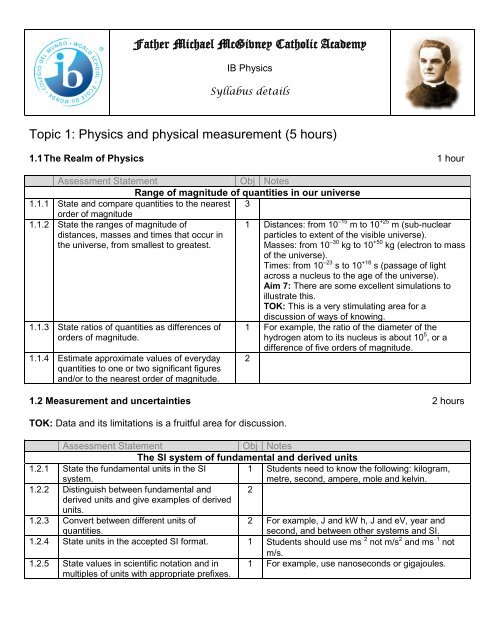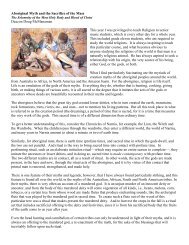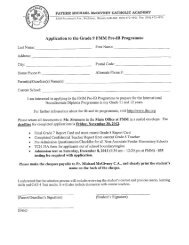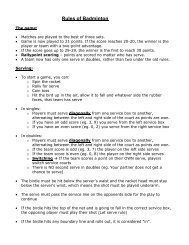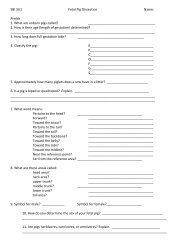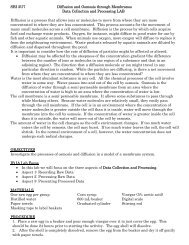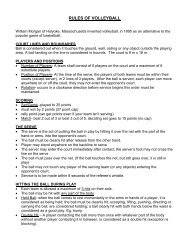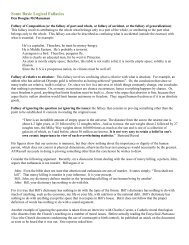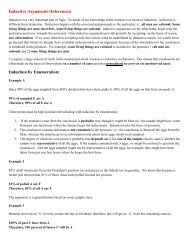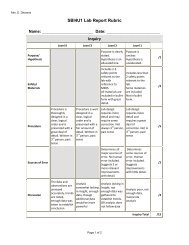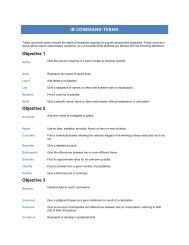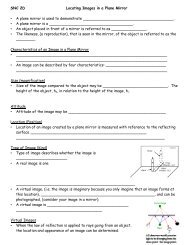Syllabus - Father Michael McGivney Catholic Academy
Syllabus - Father Michael McGivney Catholic Academy
Syllabus - Father Michael McGivney Catholic Academy
- No tags were found...
Create successful ePaper yourself
Turn your PDF publications into a flip-book with our unique Google optimized e-Paper software.
<strong>Father</strong> <strong>Michael</strong> <strong>McGivney</strong> <strong>Catholic</strong> <strong>Academy</strong>IB Physics<strong>Syllabus</strong> detailsTopic 1: Physics and physical measurement (5 hours)1.1 The Realm of Physics 1 hourAssessment StatementObj NotesRange of magnitude of quantities in our universe1.1.1 State and compare quantities to the nearest 3order of magnitude1.1.2 State the ranges of magnitude ofdistances, masses and times that occur inthe universe, from smallest to greatest.1 Distances: from 10 –15 m to 10 +25 m (sub-nuclearparticles to extent of the visible universe).Masses: from 10 –30 kg to 10 +50 kg (electron to massof the universe).Times: from 10 –23 s to 10 +18 s (passage of lightacross a nucleus to the age of the universe).Aim 7: There are some excellent simulations toillustrate this.TOK: This is a very stimulating area for a1.1.3 State ratios of quantities as differences oforders of magnitude.1.1.4 Estimate approximate values of everydayquantities to one or two significant figuresand/or to the nearest order of magnitude.discussion of ways of knowing.1 For example, the ratio of the diameter of thehydrogen atom to its nucleus is about 10 5 , or adifference of five orders of magnitude.21.2 Measurement and uncertainties 2 hoursTOK: Data and its limitations is a fruitful area for discussion.Assessment StatementObj NotesThe SI system of fundamental and derived units1.2.1 State the fundamental units in the SIsystem.1 Students need to know the following: kilogram,metre, second, ampere, mole and kelvin.1.2.2 Distinguish between fundamental and 2derived units and give examples of derivedunits.1.2.3 Convert between different units ofquantities.2 For example, J and kW h, J and eV, year andsecond, and between other systems and SI.1.2.4 State units in the accepted SI format. 1 Students should use ms –2 not m/s 2 and ms –1 notm/s.1.2.5 State values in scientific notation and inmultiples of units with appropriate prefixes.1 For example, use nanoseconds or gigajoules.
1.3 Vectors and scalars 2 hoursThis may be taught as a stand-alone topic or can be introduced when vectors are encountered inother topics such as 2.2, forces and dynamics, and 6.2, electric force and field.Assessment statement1.3.1 Distinguish between vector and scalarquantities, and give examples of each.1.3.2 Determine the sum or difference of twovectors by a graphical method.1.3.3 Resolve vectors into perpendicularcomponents along chosen axes.Obj Notes2 A vector is represented in print by a bold italicizedsymbol, for example, F.3 Multiplication and division of vectors by scalars isalso required.2 For example, resolving parallel and perpendicularto an inclined plane.Topic 2: Mechanics (17 hours)Aim 7: This topic is a fruitful one for using spreadsheets and data logging in practical work as well ascomputer simulations in teaching various concepts.2.1 Kinematics 6 hoursAssessment statement2.1.1 Define displacement, velocity, speed andacceleration.2.1.2 Explain the difference betweeninstantaneous and average values ofspeed, velocity and acceleration.2.1.3 Outline the conditions under which theequations for uniformly accelerated motionmay be applied.2.1.4 Identify the acceleration of a body falling ina vacuum near the Earth’s surface with theacceleration g of free fall.2.1.5 Solve problems involving the equations ofuniformly accelerated motion.2.1.6 Describe the effects of air resistance onfalling objects.2.1.7 Draw and analyse distance–time graphs,displacement–time graphs, velocity–timegraphs and acceleration–time graphs.2.1.8 Calculate and interpret the gradients ofdisplacement–time graphs and velocity–time graphs, and the areas under velocity–time graphs and acceleration–time graphs.2.1.9 Determine relative velocity in one and intwo dimensions.Obj Notes1 Quantities should be identified as scalar or vectorquantities. See sub-topic 1.3.32232 Only qualitative descriptions are expected.Students should understand what is meant byterminal speed.3 Students should be able to sketch and label thesegraphs for various situations. They should also beable to write descriptions of the motionsrepresented by such graphs.23
2.2 Forces and Dynamics 6 hoursTOK: The development of the laws of motion raises interesting issues relating to correlation andcause and scientific theories.Assessment statement2.2.1 Calculate the weight of a body using theexpression W = mg.2.2.2 Identify the forces acting on an object anddraw free-body diagrams representing theforces acting.Obj Notes22 Each force should be labelled by name or given acommonly accepted symbol. Vectors should havelengths approximately proportional to theirmagnitudes. See sub-topic 1.3.32.2.3 Determine the resultant force in differentsituations.2.2.4 State Newton’s first law of motion. 12.2.5 Describe examples of Newton’s first law. 22.2.6 State the condition for translational1equilibrium.2.2.7 Solve problems involving translational 3equilibrium.2.2.8 State Newton’s second law of motion. 1 Students should be familiar with the lawexpressed as:and2.2.9 Solve problems involving Newton’s second 3law.2.2.10 Define linear momentum and impulse. 12.2.11 Determine the impulse due to a timevarying3force by interpreting a force–timegraph.2.2.12 State the law of conservation of linear 1momentum.2.2.13 Solve problems involving momentum and 3impulse.2.2.14 State Newton’s third law of motion. 12.2.15 Discuss examples of Newton’s third law. 3 Students should understand that when two bodiesA and B interact, the force that A exerts on B isequal and opposite to the force that B exerts on A.2.3 Work, energy and power 3 hoursAssessment statementObj Notes2.3.1 Outline what is meant by work. 2 Students should be familiar with situations wherethe displacement is not in the same direction asthe force.2.3.2 Determine the work done by a nonconstantforce by interpreting a force–3 A typical example would be calculating the workdone in extending a spring. See 2.3.7.displacement graph.2.3.3 Solve problems involving the work done by 3a force.2.3.4 Outline what is meant by kinetic energy. 22.3.5 Outline what is meant by change ingravitational potential energy.2
Assessment statement Obj Notes2.3.6 State the principle of conservation of 1energy.2.3.7 List different forms of energy and describe 2examples of the transformation of energyfrom one form to another.2.3.8 Distinguish between elastic and inelasticcollisions.2 Students should be familiar with elastic andinelastic collisions and explosions. Knowledge ofthe coefficient of restitution is not required.2.3.9 Define power. 12.3.10 Define and apply the concept of efficiency. 22.3.11 Solve problems involving momentum, 3work, energy and power.2.4 Uniform circular motion 2 hoursThis topic links with sub-topics 6.3 and 9.4.Assessment statement2.4.1 Draw a vector diagram to illustrate that theacceleration of a particle moving withconstant speed in a circle is directedtowards the centre of the circle.2.4.2 Apply the expression for centripetalacceleration.2.4.3 Identify the force producing circular motionin various situations.Obj Notes122 Examples include gravitational force acting on theMoon and friction acting sideways on the tyres ofa car turning a corner.2.4.4 Solve problems involving circular motion. 3 Problems on banked motion (aircraft and vehiclesgoing round banked tracks) will not be included.Topic 3: Thermal physics (7 hours)3.1 Thermal concepts 2 hoursAssessment statement3.1.1 State that temperature determines thedirection of thermal energy transferbetween two objects.3.1.2 State the relation between the Kelvin andCelsius scales of temperature.3.1.3 State that the internal energy of asubstance is the total potential energy andrandom kinetic energy of the molecules ofthe substance.3.1.4 Explain and distinguish between themacroscopic concepts of temperature,internal energy and thermal energy (heat).3.1.5 Define the mole and molar mass. 13.1.6 Define the Avogadro constant. 1Obj Notes1 Students should be familiar with the concept ofthermal equilibrium.1 T/K = t/°C + 273 is sufficient.1 Students should know that the kinetic energy ofthe molecules arises from theirrandom/translational/rotational motion and that thepotential energy of the molecules arises from theforces between the molecules.3 Students should understand that the term thermalenergy refers to the non-mechanical transfer ofenergy between a system and its surroundings. Inthis respect it is just as incorrect to refer to the“thermal energy in a body” as it would be to referto the “work in a body”.
3.2 Thermal properties of matter 5 hoursAssessment statementObj NotesSpecific heat capacity, phase changes and latent heat3.2.1 Define specific heat capacity and thermal 1capacity.3.2.2 Solve problems involving specific heat 3capacities and thermal capacities.3.2.3 Explain the physical differences between 3 Only a simple model is required.the solid, liquid and gaseous phases interms of molecular structure and particlemotion.3.2.4 Describe and explain the process of phasechanges in terms of molecular behaviour.3 Students should be familiar with the terms melting,freezing, evaporating, boiling and condensing, andshould be able to describe each in terms of thechanges in molecular potential and random kineticenergies of molecules.3.2.5 Explain in terms of molecular behaviour 3why temperature does not change during aphase change.3.2.6 Distinguish between evaporation and 2boiling.3.2.7 Define specific latent heat. 13.2.8 Solve problems involving specific latent 3 Problems may include specific heat calculations.heats.Kinetic model of an ideal gasAim 7: There are many computer simulations of the behaviour of gases.TOK: The use of modelling in science may be introduced here.3.2.9 Define pressure. 13.2.10 State the assumptions of the kinetic model 1of an ideal gas.3.2.11 State that temperature is a measure of the 1average random kinetic energy of themolecules of an ideal gas.3.2.12 Explain the macroscopic behaviour of anideal gas in terms of a molecular model.Topic 4: Oscillations and waves (10 hours)3 Only qualitative explanations are required.Students should, for example, be able to explainhow a change in volume results in a change in thefrequency of particle collisions with the containerand how this relates to a change in pressureand/or temperature.4.1 Kinematics of simple harmonic motion (SHM) 2 hoursAim 7: Many computer simulations of SHM are available.Assessment statementObj Notes4.1.1 Describe examples of oscillations. 24.1.2 Define the terms displacement, amplitude,frequency, period and phase difference.1 The connection between frequency and periodshould be known.4.1.3 Define simple harmonic motion (SHM)and state the defining equation as.1 Students are expected to understand thesignificance of the negative sign in the equationand to recall the connection between ω and T.
Assessment statement Obj Notes4.1.4 Solve problems using the defining equation 3for SHM.4.1.5 Apply the equations ,2, ,andassolutions to the defining equation for SHM.4.1.6 Solve problems, both graphically and bycalculation, for acceleration, velocity anddisplacement during SHM.34.2 Energy changes during simple harmonic motion (SHM) 1 hourAssessment statement Obj Notes4.2.1 Describe the interchange between kinetic 2energy and potential energy during SHM.4.2.2 Apply the expressions2for the kinetic energy of a particleundergoing SHM,for the total energy andfor the potential energy.4.2.3 Solve problems, both graphically and bycalculation, involving energy changesduring SHM.34.3 Forced oscillations and resonance 3 hoursAssessment statement Obj Notes4.3.1 State what is meant by damping. 1 It is sufficient for students to know that dampinginvolves a force that is always in the oppositedirection to the direction of motion of theoscillating particle and that the force is adissipative force.4.3.2 Describe examples of damped oscillations. 2 Reference should be made to the degree ofdamping and the importance of critical damping. Adetailed account of degrees of damping is notrequired.4.3.3 State what is meant by natural frequency of 1vibration and forced oscillations.4.3.4 Describe graphically the variation withforced frequency of the amplitude ofvibration of an object close to its naturalfrequency of vibration.4.3.5 State what is meant by resonance. 14.3.6 Describe examples of resonance where theeffect is useful and where it should beavoided.2 Students should be able to describe qualitativelyfactors that affect the frequency response andsharpness of the curve.2 Examples may include quartz oscillators,microwave generators and vibrations inmachinery.
4.4 Wave characteristics 2 hoursAssessment statement Obj Notes4.4.1 Describe a wave pulse and a continuousprogressive (travelling) wave.2 Students should be able to distinguish betweenoscillations and wave motion, and appreciate that,in many examples, the oscillations of the particles4.4.2 State that progressive (travelling) wavestransfer energy.4.4.3 Describe and give examples of transverseand of longitudinal waves.4.4.4 Describe waves in two dimensions,including the concepts of wavefronts and ofrays.4.4.5 Describe the terms crest, trough,compression and rarefaction.4.4.6 Define the terms displacement, amplitude,frequency, period, wavelength, wave speedand intensity.4.4.7 Draw and explain displacement–timegraphs and displacement–position graphsfor transverse and for longitudinal waves.4.4.8 Derive and apply the relationship betweenwave speed, wavelength and frequency.4.4.9 State that all electromagnetic waves travelwith the same speed in free space, andrecall the orders of magnitude of thewavelengths of the principal radiations inthe electromagnetic spectrum.are simple harmonic.1 Students should understand that there is no netmotion of the medium through which the wavetravels.2 Students should describe the waves in terms ofthe direction of oscillation of particles in the waverelative to the direction of transfer of energy by thewave. Students should know that sound wavesare longitudinal, that light waves are transverseand that transverse waves cannot be propagatedin gases.221 Students should know that intensity ∝ amplitude 2 .4.5 Wave properties 2 hoursAssessment statement Obj Notes4.5.1 Describe the reflection and transmission ofwaves at a boundary between two media.2 This should include the sketching of incident,reflected and transmitted waves.4.5.2 State and apply Snell’s law. 2 Students should be able to define refractive indexin terms of the ratio of the speeds of the wave inthe two media and also in terms of the angles ofincidence and refraction.4.5.3 Explain and discuss qualitatively thediffraction of waves at apertures andobstacles.4.5.4 Describe examples of diffraction. 24.5.5 State the principle of superposition andexplain what is meant by constructiveinterference and by destructiveinterference.33313 The effect of wavelength compared to aperture orobstacle dimensions should be discussed.
Assessment statement Obj Notes4.5.6 State and apply the conditions for2constructive and for destructiveinterference in terms of path difference andphase difference.4.5.7 Apply the principle of superposition todetermine the resultant of two waves.2Topic 5: Electric currents (7 hours)5.1 Electric potential difference, current and resistance 4 hoursAssessment statement Obj Notes5.1.1 Define electric potential difference. 15.1.2 Determine the change in potential energy 3when a charge moves between two pointsat different potentials.5.1.3 Define the electronvolt. 15.1.4 Solve problems involving electric potential 3difference.Electric current and resistance5.1.5 Define electric current. 1 It is sufficient for students to know that current isdefined in terms of the force per unit lengthbetween parallel current-carrying conductors.5.1.6 Define resistance. 1 Students should be aware that5.1.7 Apply the equation for resistance inthe form2is a general definition of resistance. It is not astatement of Ohm’s law. Students shouldunderstand what is meant by resistor.where ρ is the resistivity of the material ofthe resistor.5.1.8 State Ohm’s law. 15.1.9 Compare ohmic and non-ohmic behaviour. 3 For example, students should be able to drawthe I–V characteristics of an ohmic resistor and afilament lamp.5.1.10 Derive and apply expressions for electrical 3power dissipation in resistors.5.1.11 Solve problems involving potential3difference, current and resistance.5.2 Electric circuits 3 hoursAssessment statement Obj Notes5.2.1 Define electromotive force (emf). 15.2.2 Describe the concept of internal resistance. 25.2.3 Apply the equations for resistors in seriesand in parallel.2 This includes combinations of resistors and alsocomplete circuits involving internal resistance.5.2.4 Draw circuit diagrams. 1 Students should be able to recognize and use theaccepted circuit symbols.
Assessment statement Obj Notes5.2.5 Describe the use of ideal ammeters and 2ideal voltmeters.5.2.6 Describe a potential divider. 25.2.7 Explain the use of sensors in potentialdivider circuits.3 Sensors should include light-dependent resistors(LDRs), negative temperature coefficient (NTC)thermistors and strain gauges.5.2.8 Solve problems involving electric circuits. 3 Students should appreciate that many circuitproblems may be solved by regarding the circuitas a potential divider. Students should be awarethat ammeters and voltmeters have their ownresistance.Topic 6: Fields and forces (7 hours)In this topic, students are encouraged to pay attention to the similarities and differences between thefields.TOK: The concept of fields in science is well worth exploring.6.1 Gravitational force and field (2 hours) 6.2 Electric force and field (3 hours)Assessmentstatement6.1.1 StateNewton’suniversal lawof gravitation.6.1.2 Definegravitationalfield strength.6.1.3 Determine thegravitationalfield due toone or morepoint masses.Obj Notes Assessmentstatement6.2.1 State that there aretwo types of electriccharge.6.2.2 State and apply thelaw of conservationof charge.6.2.3 Describe andexplain thedifference in theelectrical propertiesof conductors andinsulators.1 Students should be aware 6.2.4 State Coulomb’sthat the masses in the force law.law are point masses. Theforce between two sphericalmasses whose separationis large compared to theirradii is the same as if thetwo spheres were pointmasses with their massesconcentrated at the centresof the spheres.1 6.2.5 Define electric fieldstrength.3 6.2.6 Determine theelectric field strengthdue to one or morepoint charges.Obj123Notes1 Students should beaware that thecharges in the forcelaw are pointcharges.1 Students shouldunderstand theconcept of a testcharge.3
Assessmentstatement6.1.4 Derive anexpression forgravitationalfield strengthat the surfaceof a planet,assuming thatall its mass isconcentratedat its centre.6.1.5 Solveproblemsinvolvinggravitationalforces andfields.Obj Notes Assessmentstatement36.2.7 Draw the electricfield patterns fordifferent chargeconfigurations.3 6.2.8 Solve problemsinvolving electriccharges, forces andfields.ObjNotes1 These include thefields due to thefollowing chargeconfigurations: apoint charge, acharged sphere, twopoint charges, andoppositely chargedparallel plates. Thelatter includes theedge effect. Studentsshould understandwhat is meant byradial field.36.3 Magnetic force and field 2 hoursAssessment statement Obj Notes6.3.1 State that moving charges give rise to 1magnetic fields.6.3.2 Draw magnetic field patterns due tocurrents.1 These include the fields due to currents in astraight wire, a flat circular coil and a solenoid.6.3.3 Determine the direction of the force on acurrent-carrying conductor in a magneticfield.3 Different rules may be used to determine the forcedirection. Knowledge of any particular rule is notrequired.6.3.4 Determine the direction of the force on a 3charge moving in a magnetic field.6.3.5 Define the magnitude and direction of a 1magnetic field.6.3.6 Solve problems involving magnetic forces,fields and currents.3
Topic 7: Atomic and nuclear physics (9 hours)Aim 7: There are opportunities throughout this topic to look at databases, use spreadsheets, exploresimulations and perform data-logging experiments.7.1 The atom 2 hoursAssessment statement Obj NotesAtomic structure7.1.1 Describe a model of the atom thatfeatures a small nucleus surrounded byelectrons.2 Students should be able to describe a simplemodel involving electrons kept in orbit around thenucleus as a result of the electrostatic attraction7.1.2 Outline the evidence that supports anuclear model of the atom.7.1.3 Outline one limitation of the simple modelof the nuclear atom.7.1.4 Outline evidence for the existence ofatomic energy levels.Nuclear structure7.1.5 Explain the terms nuclide, isotope andnucleon.7.1.6 Define nucleon number A, proton number Zbetween the electrons and the nucleus.2 A qualitative description of the Geiger-Marsdenexperiment and an interpretation of the results areall that is required.22 Students should be familiar with emission andabsorption spectra, but the details of atomicmodels are not required.31Students should understand that light is not acontinuous wave but is emitted as “packets” or“photons” of energy, each of energy hf.and neutron number N.7.1.7 Describe the interactions in a nucleus. 2 Students need only know about the Coulombinteraction between protons and the strong, shortrangenuclear interaction between nucleons.7.2 Radioactive decay 3 hoursAssessment statement Obj NotesRadioactivity7.2.1 Describe the phenomenon of naturalradioactive decay.2 The inclusion of the antineutrino in β− decay isrequired.7.2.2 Describe the properties of alpha (α) 2and beta (β) particles and gamma(γ) radiation.7.2.3 Describe the ionizing properties ofalpha (α) and beta (β) particles andgamma (γ) radiation.2
Assessment statement Obj Notes7.2.4 Outline the biological effects of ionizingradiation.2 Students should be familiar with the direct andindirect effects of radiation on structures withincells. A simple account of short‐term and longterm effects of radiation on the body is required.Aim 8: There are moral, social and environmentalaspects to consider here.TOK: Correlation and cause, and risk7.2.5 Explain why some nuclei are stablewhile others are unstable.Half-life7.2.6 State that radioactive decay is arandom and spontaneous processand that the rate of decay decreasesexponentially with time.7.2.7 Define the term radioactive half‐life. 17.2.8 Determine the half-life of a nuclide from a 3decay curve.7.2.9 Solve radioactive decay problems involvingintegral numbers of half-lives.3assessment, can also be looked at.3 An explanation in terms of relative numbers ofprotons and neutrons and the forces involved is allthat is required.1 Exponential decay need not be treatedanalytically. It is sufficient to know that anyquantity that reduces to half its initial value in aconstant time decays exponentially. The nature ofthe decay is independent of the initial amount.7.3 Nuclear reactions, fission and fusion 4 hoursAssessment statement Obj NotesNuclear reactions7.3.1 Describe and give an example of an 2artificial (induced) transmutation.7.3.2 Construct and complete nuclear equations. 37.3.3 Define the term unified atomic mass unit. 1 Students must be familiar with the units MeV c −27.3.4 Apply the Einstein mass–energyequivalence relationship.7.3.5 Define the concepts of mass defect,binding energy and binding energy pernucleon.7.3.6 Draw and annotate a graph showingthe variation with nucleon number ofthe binding energy per nucleon.7.3.7 Solve problems involving mass defect andbinding energy.Fission and fusion7.3.8 Describe the processes of nuclear fissionand nuclear fusion.7.3.9 Apply the graph in 7.3.6 to account for theenergy release in the processes of fissionand fusion.7.3.10 State that nuclear fusion is the main sourceof the Sun’s energy.7.3.11 Solve problems involving fission and fusionreactions.21and GeV c −2 for mass.2 Students should be familiar with binding energiesplotted as positive quantities.32213
Topic 8: Energy, power and climate change (18 hours)Aim 8 and the international dimension feature strongly in all the sub-topics.8.1 Energy degradation and power generation 2 hoursAim 7: Computer simulations of Sankey diagrams feature here.Assessment statement Obj Notes8.1.1 State that thermal energy may be1completely converted to work in a singleprocess, but that continuous conversion ofthis energy into work requires a cyclicalprocess and the transfer of some energyfrom the system.8.1.2 Explain what is meant by degraded energy. 3 Students should understand that, in any processthat involves energy transformations, the energythat is transferred to the surroundings (thermalenergy) is no longer available to perform usefulwork.8.1.3 Construct and analyse energy flowdiagrams (Sankey diagrams) and identifywhere the energy is degraded.3 It is expected that students will be able toconstruct flow diagrams for various systemsincluding those described in sub-topics 8.3 and8.1.4 Outline the principal mechanisms involvedin the production of electrical power.8.4.2 Students should know that electrical energy maybe produced by rotating coils in a magnetic field.In sub-topics 8.2 and 8.3 students look in moredetail at energy sources used to provide theenergy to rotate the coils.8.2 World energy sources 2 hoursAim 7: Databases of energy statistics on a global and national scale can be explored here. Moral,environmental and economic aspects may be considered.Assessment statement Obj Notes8.2.1 Identify different world energy sources. 2 Students should be able to recognize thosesources associated with CO 2 emission.Students should also appreciate that, in mostinstances, the Sun is the prime energy source forworld energy.8.2.2 Outline and distinguish between renewable 2and non-renewable energy sources.8.2.3 Define the energy density of a fuel. 1 Energy density is measured in J kg –1 .8.2.4 Discuss how choice of fuel is influenced by 3 The values of energy density of different fuels willits energy density.8.2.5 State the relative proportions of world useof the different energy sources that areavailable.8.2.6 Discuss the relative advantages anddisadvantages of various energy sources.be provided.1 Only approximate values are needed.3 The discussion applies to all the sources identifiedin sub-topics 8.2, 8.3 and 8.4.
8.3 Fossil fuel power production 1 hourAssessment statement Obj Notes8.3.1 Outline the historical and geographicalreasons for the widespread use of fossilfuels.2 Students should appreciate that industrializationled to a higher rate of energy usage, leading toindustry being developed near to large deposits of8.3.2 Discuss the energy density of fossil fuelswith respect to the demands of powerstations.8.3.3 Discuss the relative advantages anddisadvantages associated with thetransportation and storage of fossil fuels.8.3.4 State the overall efficiency of powerstations fuelled by different fossil fuels.8.3.5 Describe the environmental problemsassociated with the recovery of fossil fuelsand their use in power stations.fossil fuels.3 Students should be able to estimate the rate offuel consumption by power stations.31 Only approximate values are required.8.4 Non-fossil fuel power production 7 hoursAim 7: Computer simulations may be shown modelling nuclear power stations and nuclear processesin general.Assessment statement Obj NotesNuclear Power8.4.1 Describe how neutrons produced in afission reaction may be used to initiatefurther fission reactions (chain reaction).2 Students should know that only low-energyneutrons (≈ 1 eV) favour nuclear fission. Theyshould also know about critical mass.8.4.2 Distinguish between controlled nuclearfission (power production) and uncontrollednuclear fission (nuclear weapons).8.4.3 Describe what is meant by fuel enrichment. 28.4.4 Describe the main energy transformations 2that take place in a nuclear power station.8.4.5 Discuss the role of the moderator and thecontrol rods in the production of controlledfission in a thermal fission reactor.38.4.6 Discuss the role of the heat exchanger in afission reactor.8.4.7 Describe how neutron capture by a nucleusof uranium-238 ( ) results in theproduction of a nucleus of plutonium-239( ).8.4.8 Describe the importance of plutonium-239( ) as a nuclear fuel.8.4.9 Discuss safety issues and risks associatedwith the production of nuclear power.22 Students should be aware of the moral and ethicalissues associated with nuclear weapons.322 It is sufficient for students to know that plutonium‐239 ( ) is used as a fuel in other types ofreactors.3 Such issues involve:• the possibility of thermal meltdown and how itmight arise• problems associated with nuclear waste• problems associated with the mining of uranium• the possibility that a nuclear power programmemay be used as a means to produce nuclearweapons.
Assessment statement Obj Notes8.4.10 Outline the problems associated withproducing nuclear power using nuclearfusion.2 It is sufficient that students appreciate the problemof maintaining and confining a high‐temperature,high-density plasma.8.4.11 Solve problems on the production of 3nuclear power.Solar Power8.4.12 Distinguish between a photovoltaic cell anda solar heating panel.8.4.13 Outline reasons for seasonal and regionalvariations in the solar power incident perunit area of the Earth’s surface.8.4.14 Solve problems involving specificapplications of photovoltaic cells and solarheating panels.Hydroelectric power8.4.15 Distinguish between different hydroelectricschemes.2 Students should be able to describe the energytransfers involved and outline appropriate uses ofthese devices.232 Students should know that the different schemesare based on:• water storage in lakes• tidal water storage• pump storage.28.4.16 Describe the main energy transformationsthat take place in hydroelectric schemes.8.4.17 Solve problems involving hydroelectric 3schemes.Wind power8.4.18 Outline the basic features of a wind2 A conventional horizontal-axis machine isgenerator.sufficient.8.4.19 Determine the power that may be delivered 3by a wind generator, assuming that thewind kinetic energy is completely convertedinto mechanical kinetic energy, and explainwhy this is impossible.8.4.20 Solve problems involving wind power. 3Wave power8.4.21 Describe the principle of operation of an 2 Students should be aware that energy from aoscillating water column (OWC) oceanwavewater wave can be extracted in a variety ofenergy converter.different ways, but only a description of theOWC8.4.22 Determine the power per unit length of a 3wavefront, assuming a rectangular profilefor the wave.8.4.23 Solve problems involving wave power. 3is required.
8.5 Greenhouse effect 3 hoursAim 7: Computer simulation, spreadsheets and databases have a significant role here.Assessment statement Obj Notes8.5.1 Calculate the intensity of the Sun’s2radiation incident on a planet.8.5.2 Define albedo. 18.5.3 State factors that determine a planet’salbedo.1 Students should know that the Earth’s albedovaries daily and is dependent on season (cloudformations) and latitude. Oceans have a low valuebut snow a high value. The global annual meanalbedo is 0.3 (30%) on Earth.The greenhouse effect8.5.4 Describe the greenhouse effect. 28.5.5 Identify the main greenhouse gases andtheir sources.8.5.6 Explain the molecular mechanisms bywhich greenhouse gases absorb infraredradiation.2 The gases to be considered are CH 4 , H 2 O, CO 2and N 2 O. It is sufficient for students to know thateach has natural and man-made origins.3 Students should be aware of the role played byresonance. The natural frequency of oscillation ofthe molecules of greenhouse gases is in theinfrared region.8.5.7 Analyse absorption graphs to compare therelative effects of different greenhousegases.3 Students should be familiar with, but will not beexpected to remember, specific details of graphsshowing infrared transmittance through a gas.8.5.8 Outline the nature of black-body radiation. 2 Students should know that black-body radiation isthe radiation emitted by a “perfect” emitter.8.5.9 Draw and annotate a graph of the emission 2spectra of black bodies at differenttemperatures.8.5.10 State the Stefan–Boltzmann law and apply 2it to compare emission rates from differentsurfaces.8.5.11 Apply the concept of emissivity to compare 2the emission rates from the differentsurfaces.8.5.12 Define surface heat capacity C s . 1 Surface heat capacity is the energy required toraise the temperature of unit area of a planet’ssurface by one degree, and is measured in J m –28.5.13 Solve problems on the greenhouse effectand the heating of planets using a simpleenergy balance climate model.K –1 .3 Students should appreciate that the change of aplanet’s temperature over a period of time is givenby:(incoming radiation intensity – outgoing radiationintensity) × time / surface heat capacity.Students should be aware of limitations of themodel and suggest how it may be improved.Aim 7: A spreadsheet should be used to show asimple climate model. Computer simulations couldbe used to show more complex models (see OCCfor details).TOK: The use and importance of computermodelling can be explained as a powerful meansby which knowledge may be gained.
8.6 Global warming 3 hoursInt: The importance of the international dimension in scientific research to solve global problems canbe demonstrated here.Assessment statement Obj NotesGlobal warming8.6.1 Describe some possible models of globalwarming.2 Students must be aware that a range of modelshas been suggested to explain global warming,including changes in the composition ofgreenhouse gases in the atmosphere, increasedsolar flare activity, cyclical changes in the Earth’s8.6.2 State what is meant by the enhancedgreenhouse effect.8.6.3 Identify the increased combustion of fossilfuels as the likely major cause of theenhanced greenhouse effect.8.6.4 Describe the evidence that links globalwarming to increased levels of greenhousegases.8.6.5 Outline some of the mechanisms that mayincrease the rate of global warming.orbit and volcanic activity.1 It is sufficient for students to be aware thatenhancement of the greenhouse effect is causedby human activities.2 Students should be aware that, althoughdebatable, the generally accepted view of mostscientists is that human activities, mainly related toburning of fossil fuels, have released extra carbondioxide into the atmosphere.2 For example, international ice core researchproduces evidence of atmospheric compositionand mean global temperatures over thousands ofyears (ice cores up to 420,000 years have beendrilled in the Russian Antarctic base, Vostok).2 Students should know that:• global warming reduces ice/snow cover, whichin turn changes the albedo, to increase rate ofheat absorption• temperature increase reduces the solubility ofCO 2 in the sea and increases atmosphericconcentrations• deforestation reduces carbon fixation.8.6.6 Define coefficient of volume expansion. 1 Students should know that the coefficient ofvolume expansion is the fractional change involume per degree change in temperature.8.6.7 State that one possible effect of theenhanced greenhouse effect is a rise inmean sea-level.8.6.8 Outline possible reasons for a predictedrise in mean sea-level.8.6.9 Identify climate change as an outcome ofthe enhanced greenhouse effect.8.6.10 Solve problems related to the enhancedgreenhouse effect.12 Students should be aware that precise predictionsare difficult to make due to factors such as:• anomalous expansion of water• different effects of ice melting on sea watercompared to ice melting on land.23 Problems could involve volume expansion,specific heat capacity and latent heat.
Assessment statement Obj Notes8.6.11 Identify some possible solutions to reducethe enhanced greenhouse effect.2 Students should be aware of the following:• greater efficiency of power production• replacing the use of coal and oil with natural gas• use of combined heating and power systems(CHP)• increased use of renewable energy sources andnuclear power• carbon dioxide capture and storage8.6.12 Discuss international efforts to reduce theenhanced greenhouse effect.Options SLOption A: Sight and wave phenomena (15 hours)• use of hybrid vehicles.3 These should include, for example:• Intergovernmental Panel on Climate Change(IPCC)• Kyoto Protocol• Asia-Pacific Partnership on Clean Developmentand Climate (APPCDC).Aim 7: Computer simulations could be very helpful in illustrating the different ideas in this option.A1 The eye and sight 3 hoursA.1.1A.1.2A.1.3A.1.4A.1.5A.1.6Assessment statement Obj NotesDescribe the basic structure of the human 2 The structure should be limited to those featureseye.affecting the physical operation of the eye.State and explain the process of depth of 3 The near point and the far point of the eye forvision and accommodation.normal vision are also included.State that the retina contains rods and 2cones, and describe the variation in densityacross the surface of the retina.Describe the function of the rods and of the 2 Students should be able to sketch and interpretcones in photopic and scotopic vision.spectral response graphs and give an explanationfor colour blindness.Describe colour mixing of light by addition 2 Students should be able to “identify” primary andand subtraction.Discuss the effect of light and dark, andcolour, on the perception of objects.secondary colours.3 Students should consider architectural effects oflight and shadow (for example, deep shadowgives the impression of massiveness). Glow canbe used to give an impression of “warmth” (forexample, blue tints are cold) or to change theperceived size of a room (for example, lightcoloured ceilings heighten the room).TOK: This can contribute to a discussion onperception.
Wave phenomena: (A2-A6 are identical to 11.1-11.5).A2 Standing (stationary) waves 2 hoursAssessment statement Obj NotesA.2.1 Describe the nature of standing (stationary)waves.2 Students should consider energy transfer,amplitude and phase.A.2.2 Explain the formation of one‐dimensionalstanding waves.3 Students should understand what is meant bynodes and antinodes.A.2.3 Discuss the modes of vibration of stringsand air in open and in closed pipes.3 The lowest-frequency mode is known either as thefundamental or as the first harmonic. The termovertone will not be used.A.2.4 Compare standing waves and travelling 3waves.A.2.5 Solve problems involving standing waves. 3A3 Doppler effect 2 hoursA.3.1A.3.2A.3.3A.3.4A.3.5Assessment statement Obj NotesDescribe what is meant by the Doppler 2effect.Explain the Doppler effect by reference to 3wavefront diagrams for moving-detectorand moving-source situations.Apply the Doppler effect equations for 2sound.Solve problems on the Doppler effect for 3 Problems will not include situations where bothsound.source and detector are moving.Solve problems on the Doppler effect for 3 Students should appreciate that the approximationelectromagnetic waves using themay be used only when v
A5 Resolution 4 hoursA.5.1A.5.2Assessment statement Obj NotesSketch the variation with angle ofdiffraction of the relative intensity of lightemitted by two point sources that has beendiffracted at a single slit.State the Rayleigh criterion for images oftwo sources to be just resolved.3 Students should sketch the variation where thediffraction patterns are well resolved, just resolvedand not resolved.1 Students should know that the criterion for acircular aperture isA.5.3 Describe the significance of resolution in 2the development of devices such as CDsand DVDs, the electron microscope andradio telescopes.A.5.4 Solve problems involving resolution. 3 Problems could involve the human eye and opticalinstruments.A6 Polarization 3 hoursAssessment statement Obj NotesA.6.1 Describe what is meant by polarized light. 2A.6.2 Describe polarization by reflection. 2 This may be illustrated using light or microwaves.The use of polarized sunglasses should beincluded.A.6.3 State and apply Brewster’s law. 2A.6.4 Explain the terms polarizer and analyser. 3A.6.5 Calculate the intensity of a transmitted 2beam of polarized light using Malus’ law.A.6.6 Describe what is meant by an opticallyactive substance.2 Students should be aware that such substancesrotate the plane of polarization.A.6.7 Describe the use of polarization in the 2determination of the concentration ofcertain solutions.A.6.8 Outline qualitatively how polarization may 2A.6.9be used in stress analysis.Outline qualitatively the action of liquidcrystaldisplays (LCDs).A.6.10 Solve problems involving the polarizationof light.2 Aim 8: The use of LCD screens in a wide varietyof different applications/devices can bementioned.3
Option B: Quantum physics and nuclear physics (15 hours)TOK: This option raises fundamental philosophical problems related to the nature of observation andmeasurement. The concept of paradigm shift can be developed here.B1–B2 are identical to 13.1–13.2.B1 Quantum physics 10 hoursAssessment statement Obj NotesThe quantum nature of radiationB.1.1 Describe the photoelectric effect. 2B.1.2Describe the concept of the photon anduse it to explain the photoelectric effect.B.1.3 Describe and explain an experiment to testthe Einstein model.B.1.4 Solve problems involving the photoelectriceffect.The wave nature of matterB.1.5 Describe the de Broglie hypothesis and theconcept of matter waves.3 Students should be able to explain why the wavemodel of light is unable to account for thephotoelectric effect, and be able to describe andexplain the Einstein model.3 Millikan’s experiment involving the application of astopping potential would be suitable.32 Students should also be aware of wave–particleduality (the dual nature of both radiation andmatter).B.1.6 Outline an experiment to verify the deBroglie hypothesis.2 A brief outline of the Davisson–Germerexperiment will suffice.B.1.7 Solve problems involving matter waves. 3 For example, students should be able to calculatethe wavelength of electrons after accelerationthrough a given potential difference.Atomic spectra and atomic energy statesB.1.8Outline a laboratory procedure forproducing and observing atomic spectra.B.1.9 Explain how atomic spectra provideevidence for the quantization of energy inatoms.B.1.10 Calculate wavelengths of spectral linesfrom energy level differences and viceversa.B.1.11 Explain the origin of atomic energy levelsin terms of the “electron in a box” model.2 Students should be able to outline procedures forboth emission and absorption spectra. Details ofthe spectrometer are not required.3 An explanation in terms of energy differencesbetween allowed electron energy states issufficient.2 Aim 7: Computer simulations showing the linkbetween energy level transitions and spectral linesassist understanding.3 The model assumes that, if an electron is confinedto move in one dimension by a box, the de Brogliewaves associated with the electron will bestanding waves of wavelength,Where L is the length of the box and n is apositive integer. Students should be able to showthat the kinetic energy E K of the electron in thebox is given by
Assessment statement Obj NotesB.1.12 Outline the Schrodinger model of thehydrogen atom.2 The model assumes that electrons in the atommay be described by wavefunctions. The electronhas an undefined position, but the square of theamplitude of the wavefunction gives the probabilityB.1.13 Outline the Heisenberg uncertaintyprinciple with regard to position–momentum and time–energy.of finding the electron at a particular point.2 Students should be aware that the conjugatequantities, position–momentum and time–energy,cannot be known precisely at the same time. Theyshould know of the link between the uncertaintyprinciple and the de Broglie hypothesis. Forexample, students should know that, if a particlehas a uniquely defined de Broglie wavelength,then its momentum is known precisely but allknowledge of its position is lost.B2 Nuclear physics 5 hoursB.2.1B.2.2B.2.3Assessment statement Obj NotesExplain how the radii of nuclei may beestimated from charged particle scatteringexperiments.Describe how the masses of nuclei may bedetermined using a Bainbridge massspectrometer.Describe one piece of evidence for theexistence of nuclear energy levels.Radioactive decayB.2.4 Describe β + decay, including the existenceof the neutrino.B.2.5B.2.6B.2.7B.2.8State the radioactive decay law as anexponential function and define the decayconstant.Derive the relationship between decayconstant and half‐life.Outline methods for measuring the half‐lifeof an isotope.Solve problems involving radioactive halflife.3 Use of energy conservation for determiningclosest-approach distances for Coulombscattering experiments is sufficient.2 Students should be able to draw a schematicdiagram of the Bainbridge mass spectrometer, butthe experimental details are not required. Studentsshould appreciate that nuclear mass valuesprovide evidence for the existence of isotopes.2 For example, alpha (α) particles produced by thedecay of a nucleus have discrete energies;gamma‐ray (γ‐ray) spectra are discrete.Students should appreciate that the nucleus, likethe atom, is a quantum system and, as such, hasdiscrete energy levels.2 Students should know that β energy spectra arecontinuous, and that the neutrino was postulatedto account for these spectra.132 Students should know the principles ofmeasurement for both long and short half‐lives.3


